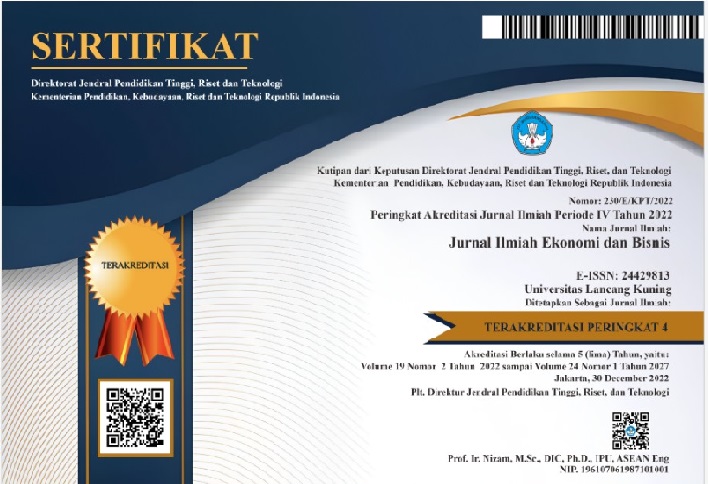PENGARUH KOMITMEN PROFESIONAL MULTI DIMENSI TERHADAP PERILAKU UNDERREPORTING OF TIME (STUDI EMPIRIS PADA KANTOR AKUNTAN PUBLIK SECOND TIERS DI INDONESIA)
Abstract
Abstract: The purpose of this study is to determine the commitment of professional affective, professional commitment continuance, normative professional commitment to underreporting of time behavior. The population in this study is the auditor at Public Accounting Firm second tiers in Indonesia. Collection of sample of 70 people. Data processing is done by structural equation modeling analysis using WarpPLS 5.0 software. The results show that professional commitment has a positive effect on underreporting of time behavior. This indicates that the higher the professional auditor's commitment, the better the auditor handles the underreporting of time behavior, and the lower the auditor's professional commitment, the lower the ability to handle underreporting of time behavior.
Keywords: Professional Affective Commitment, Continuance Professional Commitment, Normative Professional Commitment, Underreporting Of Time Behavior
Downloads
References
Adanan Silaban., 2009, Perilaku Disfungsional Auditor Dalam Pelaksanaan Program Audit, Disertasi, Universitas Diponegoro, Semarang.
Allen B.A and Leary M.R. 2010, Self-Comassion, stress, and Coping, Social and Personality Psychology Compass: 107-118.
DeAngelo L.E. 1981, Auditor Size and Auditor Quality, Journal of Accounting and Economics 3, 183-199, North-Holland Publishing Company.
Choo F. 1986, Job Stress, Job Performance, and Auditor Personality Characteristict, Auditing : A Journal of Practices and Theory, Vol. 5 No.2, pp. 17-34.
Ghozali, I. dan Fuad (2012) Structural Equation Modeling : Teori, Konsep, dan Aplikasi Dengan Lisrel 8.80, Semarang : UNDIP Press.
Gundry C.L. 2006, The Effect of Time Budget Pressure and Auditor’s Personality Type on Reduce Audit Quality Practices, Dissertation, University of Otago, Dunedin, New Zealand.
Hair, J. F., M. Sarstedt, C. M. Ringle, dan J. A. Mena. (2012) “An Assessment of the Use off Partial Least Squares Structural Equation Modeling in Marketing Research”, Journal of the Academy of Marketing Science. Vol. 40 No. 1, pp. 414-433.
Hair, J. F., M. Sarstedt, L. Hopkins, V. G. Kuppelwieser. (2014) “Partial Least Squares Structural Equation Modeling (PLS-SEM): An Emerging Tool in Business Research”. European Business Review. Vol. 26 No. 2, pp. 106-121.
Hartono J. (2011) Konsep dan Aplikasi Structural Equation Modeling Berbasis Varian dalam Penelitian Bisnis. Yogyakarta : UPP STIM YKPN.
Hartono. J. (2015) Metodologi Penelitian Bisnis : Salah Kaprah dan Pengalaman-Pengalaman. Edisi 6. Yogyakarta : BPFE.
Paino, H dan Thani, A.I.S., 2011, Attitudes Toward Dysfunctional Audit Behavior: The Effect of Budget Emphasis, Leadership Behavior, and Effectiveness of Audit review, Journal of Modern Accounting and Auditing, December, Vol.7, No. 12, 1344-1351.
Hall M. Smith D and Smith K.L. 2005 Accountants’ Commitment to Their Profession: Multiple Dimensions of Professional Commitment and Opportunisties for Future Research, Behavioral Research in Accounting; 2005; 17, pg.89.
Jaros S. 2007, Meyer and Allen Model of Organizational Commitment: Mesurement Issues, The Icfai journal of Organizational Behavior, Vol. VI, No. 4, The Icfai University Press.
Maya Febrianty Lautina, 2011, Pengaruh Time Budget Pressure, Locus of Control dan Perilaku Disfungsional Audit Terhadap Kinerja Auditor, dalam Jurnal Telaah & Riset, Vol. 4 No. 1. Januari 2011, Hal. 92-113.
McNamara S.M and Liyanarachchi., G.A. 2008, Time Budget Pressure and Auditor Dysfuctional Behaviour Within an Occupational Stress Model, Accountancy Business and the Public Interest, Vol. 7, No. 1, 2008.
Muslim A. 2014, Locus of Control, Commitment Professional and Dysfunctional Audit Behaviour, International Journal of Humanities and Management Sciences (IJHMS) Volume 2, 2320-4044.
Mustafa EQ, Z. (2009) Mengurai Variabel hingga Instrumen, Graha Ilmu, Yogyakarta.
Richardson W.D and Ford R.C. 1994, Ethical Decision Making: A Review of the Empirical Literature, Journal of Business Ethics, Vol, 13, pp. 205-221.
Shaub M.K, Find D.W and Munter P. 1993, The Effects of Auditors’ Ethical Orientation on Commitment and Ethical Sensitivity, Behavioral Research in Accounting, Vol. 5. Pp. 145-169
Soobaroyen T and Chengabroyan C. 2006, Auditor’s Perceptions of Time Budget Pressure, Prematute Sign Offs and Under-Reporting of Chargeable Time: Evidance from a Developing Country, International Journal of Auditing, Int. J. Audit. 10: 201-218.
Solihin, M. dan D. Ratmono. (2013). Analisis SEM-PLS dengan WarpPLS 3.0, Yogyakarta : Andi.
Sugiyono (2011) Metode Penelitian Bisnis. Alfabeta. Bandung.
Otley D.T and Pierce B.J. 1996, Auditor Time Budget pressure: Consequences and Antecedents, Accounting, Auditing & Accountability Journal, Vol. 9 No. 1, 1996, pp. 31-58.
Wibowo, H., S. (2014). SEM With Lisrel, Modul Pelatihan Pusat Pendidiikan dan Pelayanan (P3M) Universitas Indonesia, Depok.
Yuen D.C.Y, Law,P.K. F, Lun., C dan Guan J. 2012, Dysfunctional Auditing Behaviour: Empirical Evidence on Auditor’s Behaviour in Macau, International Journal of Accounting and Information Management, pp. 1-20










 This work is licensed under a Attribution 4.0 International (CC BY 4.0)
This work is licensed under a Attribution 4.0 International (CC BY 4.0) 